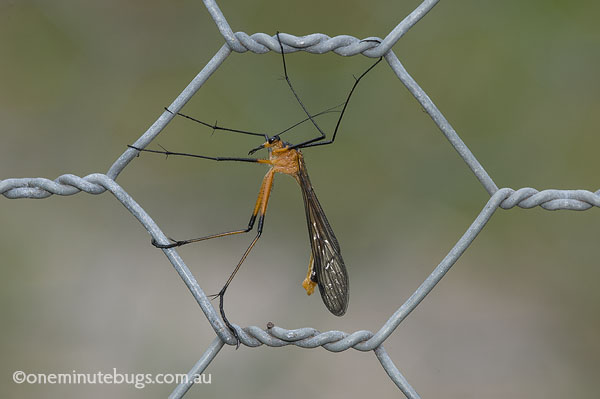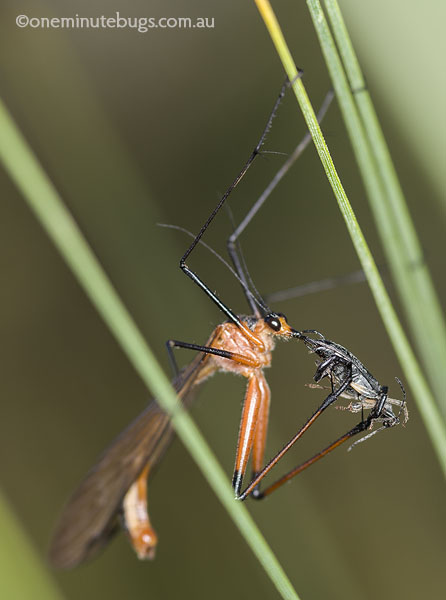Mecoptera is a minor insect order with only 27 known species found in Australia. Members of this order are often called ‘scorpionflies’ or ‘scorpion flies’ because males of the family Panorpidae (which doesn’t occur in Australia) have curving genital segments resembling a scorpion sting (below).

Males of common Australian species don’t have this ‘scorpion tail’. Australian species are often called ‘hanging flies’ because they hang from plants (and other objects as you can see below) by their forelegs and midlegs. Various species of the genus Harpobittacus, our most common scorpion flies, are found in eastern and southern Australia, including Tasmania and south-west Western Australia. They are often mistaken, especially when flying, for other long-legged insects such as crane flies or large (very large!) mosquitoes.

Common Australian scorpion flies usually have slender elongated bodies and very long legs, with long narrow wings with a span of up to 50mm. Scorpion flies have a distinct beak and two pairs of wings (unlike true flies of the order Diptera, which have just one pair). Common species of scorpion flies are black and reddish brown, or fully black.
Scorpion flies are predatory and do all their grasping and manipulation with their hind legs. They can catch passing insects with their hind legs, or may actively hunt for prey among plants, sweeping them with their hind legs. They are amazingly dexterous with those gangly legs. The scorpion fly in the image below was particularly deft. It was eating a beetle from one end and then spun the carcass end over end like a football (an AFL football that is), so it could begin feeding from the other end.

Males give off pheromones to attract females from a distance. To entice a female closer a male offers the female a nuptial meal of an insect he has caught with his gangly hind legs. Females choose males by the size of the offered meal – the male in the image below was certain to mate because he has offered two flies as a meal. Fly nerds will notice that one part of the meal is a species of hover fly (Syrphidae) and the other is a species of blowfly (Calliphoridae). Mating may last up to 10 minutes, but once mating has finished the male flies off, along with his gift, to find another female. Males may mate with as many as 8 females per day.

Once their eggs are fertilised, females drop their eggs on the ground, where the eggs may lie dormant for several months. After hatching, the larvae (which superficially resemble caterpillars) feed on dead insects and plant material and moult through four growth stages. Pupation takes place in a cell in the upper levels of soil. There is only one generation per year.
Scorpion flies may look a bit weird and/or scary to some people, but there is no need to be alarmed – they are useful garden predators. Of course, insect nerds like myself find them endlessly fascinating!
Wow! How fascinating! I love your photos! Where did you photograph these ones? I would love to see them and have a go at photographing them too
Thanks Maree. These were photographed in western Victoria in the Grampians region.